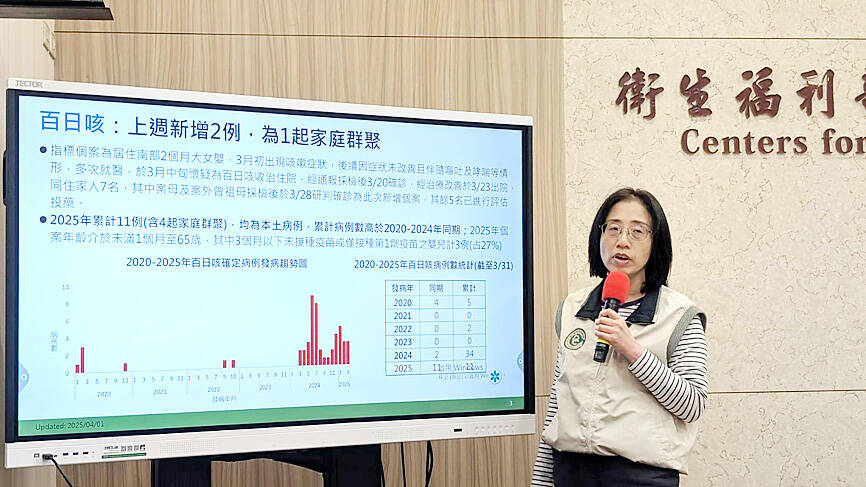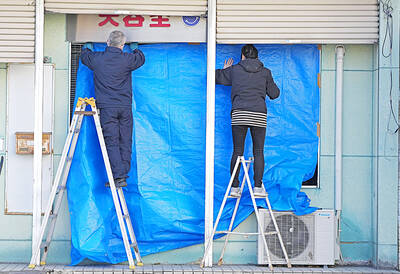Two cases of pertussis, also known as whooping cough, were reported last week among members of a family in southern Taiwan, and 99 close contacts are being monitored, the Centers for Disease Control (CDC) said yesterday.
CDC Epidemic Intelligence Center Deputy Director Lee Chia-lin (李佳琳) said the two cases of whooping cough were reported in the same family, pushing the accumulated case number this year to 11, the highest for the same period in six years.
The two new cases are family members of a previous case, a two-month-old girl who began coughing early last month. Her parents sought treatment several times for coughing, vomiting and asthma, and she was hospitalized for suspected whooping cough, Lee said.

Photo: CNA
The girl was diagnosed with whooping cough on March 20 and discharged from hospital on March 23, and her seven family members who live with her were tested, with results issued on Friday last week confirming her mother and great grandmother had whooping cough, she said.
The girl was not old enough to be vaccinated when she was infected, and the CDC found that her great-grandmother was coughing in January, so she is likely to be the source of the infections within the family, CDC physician Lee Tsung-han (李宗翰) said.
The 99 close contacts of the cases have been identified, and they should monitor their health conditions until April 22, the CDC said.
Whooping cough is an acute respiratory infection, mainly transmitted through airborne droplets, with an incubation period of five to 21 days, Lee Tsung-han said, adding that it is less severe in older children and adults, but can be particularly severe in young children, especially infants under six months old.
Vaccination is the best method for preventing the disease, so infants should get the recommended doses of vaccine at the ages of two, four, six and 18 months, he said.
With no cases reported in 2021, two cases in 2022 and none in 2023, whooping cough activity began rising last year, with cases reported nearly every month, Lee Chia-lin said, adding that a similar trend has been observed in other countries.
In Japan, cases have rapidly increased this year, with more than 3,500 reported so far, the highest number since 2018. China reported more than 9,900 cases in the first two months of the year, lower than the same period last year, when it had more than 490,000 cases, she said.
Whooping cough activity was not particularly serious last month, but the accumulated number this year is higher than previous years, and with the Tomb Sweeping Day approaching, the CDC reminds people to be cautious when traveling, CDC Deputy Director-General Philip Lo (羅一鈞) said.
Meanwhile, monitoring data from contracted labs showed that respiratory pathogens are still relatively active, and in the past four weeks the influenza virus has been the most common viral pathogen detected, followed by parainfluenza virus and rhinovirus, Lee Chia-lin said.
She said while COVID-19 activity remains low, hospital visits increased by 4.9 percent last week, and a new death was confirmed.
As protection from vaccines would wane over time, a second dose of the JN-1-adapted vaccine would be available to people aged 65 or older, as well as immunocompromised people, starting on Tuesday next week, Lo said.

Taiwanese were praised for their composure after a video filmed by Taiwanese tourists capturing the moment a magnitude 7.5 earthquake struck Japan’s Aomori Prefecture went viral on social media. The video shows a hotel room shaking violently amid Monday’s quake, with objects falling to the ground. Two Taiwanese began filming with their mobile phones, while two others held the sides of a TV to prevent it from falling. When the shaking stopped, the pair calmly took down the TV and laid it flat on a tatami mat, the video shows. The video also captured the group talking about the safety of their companions bathing

US climber Alex Honnold is to attempt to scale Taipei 101 without a rope and harness in a live Netflix special on Jan. 24, the streaming platform announced on Wednesday. Accounting for the time difference, the two-hour broadcast of Honnold’s climb, called Skyscraper Live, is to air on Jan. 23 in the US, Netflix said in a statement. Honnold, 40, was the first person ever to free solo climb the 900m El Capitan rock formation in Yosemite National Park — a feat that was recorded and later made into the 2018 documentary film Free Solo. Netflix previewed Skyscraper Live in October, after videos

Starting on Jan. 1, YouBike riders must have insurance to use the service, and a six-month trial of NT$5 coupons under certain conditions would be implemented to balance bike shortages, a joint statement from transportation departments across Taipei, New Taipei City and Taoyuan announced yesterday. The rental bike system operator said that coupons would be offered to riders to rent bikes from full stations, for riders who take out an electric-assisted bike from a full station, and for riders who return a bike to an empty station. All riders with YouBike accounts are automatically eligible for the program, and each membership account

A classified Pentagon-produced, multiyear assessment — the Overmatch brief — highlighted unreported Chinese capabilities to destroy US military assets and identified US supply chain choke points, painting a disturbing picture of waning US military might, a New York Times editorial published on Monday said. US Secretary of Defense Pete Hegseth’s comments in November last year that “we lose every time” in Pentagon-conducted war games pitting the US against China further highlighted the uncertainty about the US’ capability to intervene in the event of a Chinese invasion of Taiwan. “It shows the Pentagon’s overreliance on expensive, vulnerable weapons as adversaries field cheap, technologically